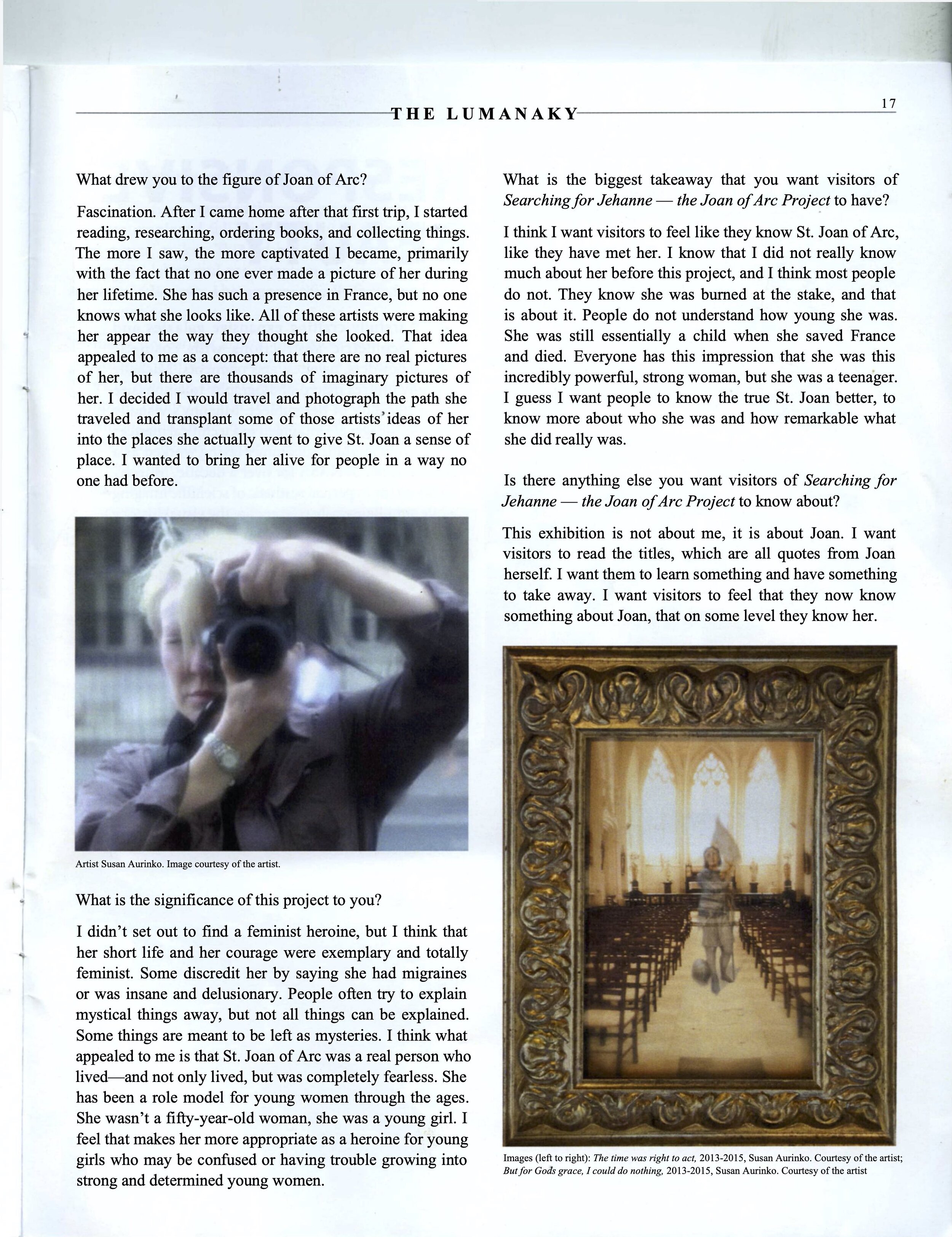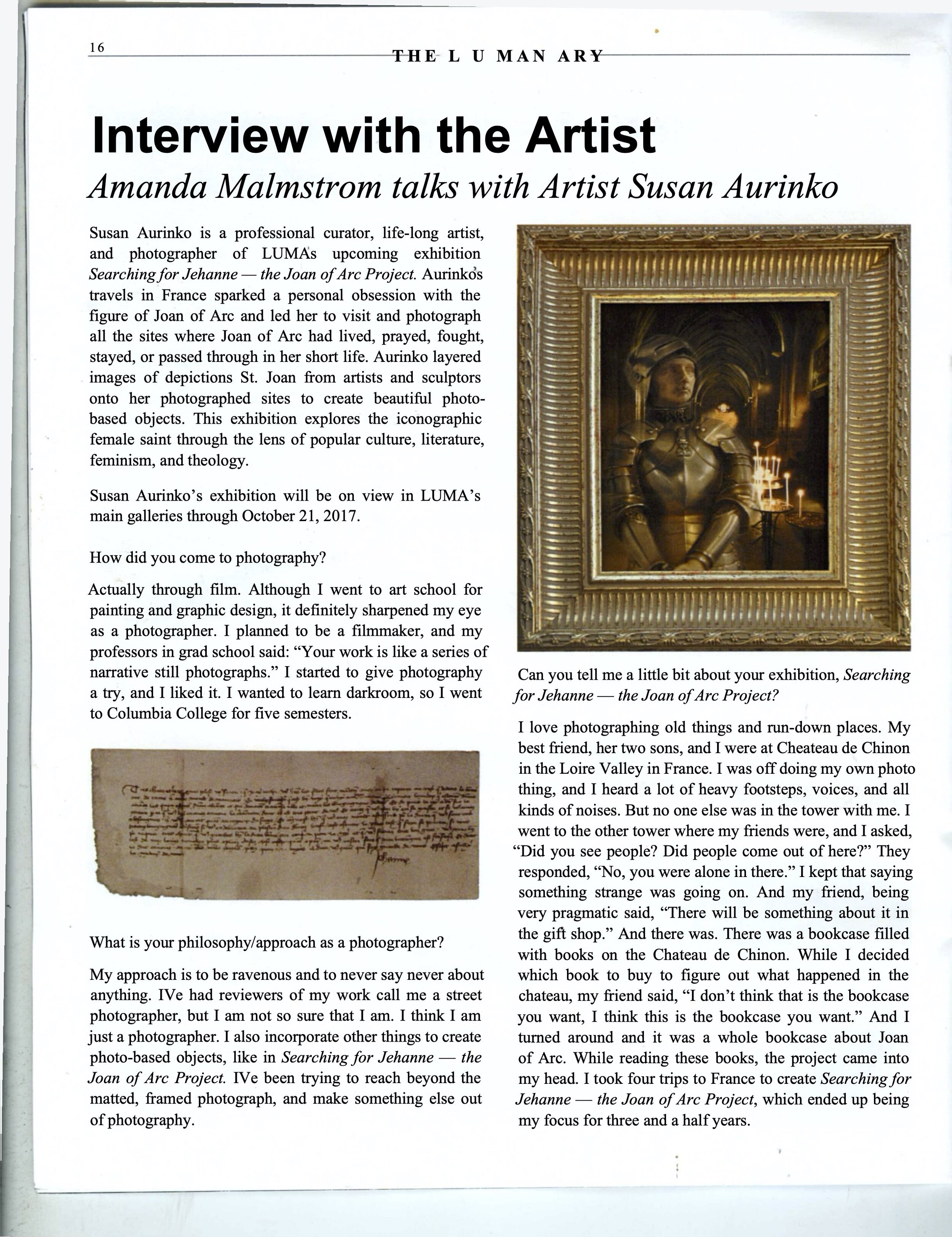Interviews:
In Other(s) Words: An Interview With Susan Aurinko by Lisa Goesling
http://voyagechicago.com/interview/meet-susan-aurinko-aurinko-photo-currently-west-loop/
https://www.classicchicagomagazine.com/susan-aurinko-captures-joan-of-arc/
https://www.youtube.com/watch?v=UrlN4upRMxA
https://youtu.be/_7xvjtOlnRQ (A Doug Vanderhoof film about my process)
https://vimeo.com/436845855 with Misha Goro for Photography &______.
Reviews:
http://finestraartspace.com/news/chicagotribune.pdf
SUSAN AURINKO-WINDOWS/WALLS
Susan Aurinko/Chicago Photography Center - One of the most gifted and accomplished street photographers still plying the trade, Susan Aurinko exploits the possibilities of such subjects as multi-layered peeling wall posters and mannequins shot through shop windows to produce intriguing complex images—mainly in traditional black and white—that finely balance the aesthetic power of abstraction with political and cultural meaning. Whereas most wall and window photographers today go for bold color that heightens hype and emotion, Aurinko’s studies are muted and nuanced, making us explore details that escape us in ordinary perception, and impelling us into a meditative mood. Aurinko demonstrates that she can also be thoroughly postmodern with two digital color prints depicting advertising posters of sultry insouciant women that are suffused with reflections from the street. Here she also strikes a balance, this time between her native subtlety and the assertiveness of her medium. Whatever Aurinko does, there is always a play of opposites expressed in layered involvement. (Michael Weinstein) Newcity - See actual review at: http://art.newcity.com/2010/03/29/review-susan-aurinkochicago-photography-center/#sthash.dcLpOvVh.dpuf
Also from Newcity:
Susan Aurinko: India Song @Th!nkart - RECOMMENDED
Using a filter to give an impressionist feel to her rich and subtly toned color photographs of the streets of the old urbs of India, Susan Aurinko has grafted her eye to Indian culture, depicting it through her empathy with its own sensibilities. Aurinko’s strategy is to distance us just enough from her subjects to let us contemplate the endless cycle of appearances that Hindus call the “veil of Maya,” which plays on the surface of perception and obscures the unity of being. A practiced and powerful wall photographer, Aurinko offers two muted yet lush prints of walls covered with decaying posters that dissolve into abstractions, with the exception of Coca-Cola signage that is overwhelmed by a plethora of faded local pitches. Even the multi-nationals cannot escape the inexorable cycle of existence. (Michael Weinstein)
Review: Around the World Chicago Photography Center RECOMMENDED
What happens when hardcore photographic pros get smitten with wanderlust and tote their gear to distant shores? They don’t take tourist shots, but there the similarity ends. Dianne Kittle could have stayed home; her color studies from various exotic places are so exquisitely composed and her human subjects so depersonalized that we are too consumed by the images’ formal perfections to focus on their representational content. The opposite is the case for Judith Petacque’s African street shots, which give the National Geographic style an injection of energy. Photo-journalist Jose More strikes a balance between form and content in his street shots from around the world; in the banner shot of the show, More captures a busy shadowed subway entrance in St. Petersburg, Russia, dominated by a nearly silhouetted street performer flanked by throngs about their business, most notably a silhouetted businessman with his briefcase looking like the essence of existential angst. In contrast to the street shooters, Barbara Levy-Kipper (India) and Candace Casey (UAE, Native Americans) zero in for intense close-up portraits of their subjects that, in Kipper’s case, give us the bite that a real person who has broken the personal space barrier inflicts; they are too individually real for comfort. And then there is Susan Aurinko, the only art photographer in “Around the World,” whose muted color studies of the old quarters of Indian cities are decidedly impressionist, as though we were enveloped by an alien sense of place. Unlike Kittle, Aurinko had to be there and surrender her senses to the scene. (Michael Weinstein)
Also from Newcity:
https://art.newcity.com/2014/07/12/review-susan-aurinko-and-tammy-kohltakohl/
https://art.newcity.com/2014/12/24/newcitys-top-5-of-everything-2014-art/
And, from writer Alexis Rotella- Susan Aurinko is a photographer, curator, and writer currently living in Chicago. Her work has been created, seen, and read across the globe. She firmly believes that photography should be visual poetry and words should create images, and aims for that goal in her own work and the exhibitions she curates.
From my second exhibition in Italy-
Aurinko e Andreini…EXHIBITION -IL MOLINI, Portogruaro, Italy
GLI AFFASCINANTI MURI DI DUE FOTOGRAFI-Giancarlo Pauletto
04-01-2006 Venice Italy
ENGLISH TRANSLATION OF AURINKO PORTION OF REVIEW:
In the case of Susan Aurinko, an American photographer of immediately perceivable abilities, we can speak, I believe, of an attention aimed at considering what is still positive, constructive, in short, vitally stimulating, these continents of signs are able to suggest. She approaches these rubble in a substantially optimistic way, like that of the archaeologist who is happy in front of the remains emerging from the ground, because she knows that through them it will be possible to reconstruct a chapter of life and existence, no less fascinating for the fact to be passed.
It is for this reason, I believe, that the essential characteristic of her photographs is a constructive formalization kept in perfect balance by the rigorous black and white, so that the images, although so moved and unpredictable in their content elements, appear to be "classical" composure, assume a definitive iconicity, in which disparate visual elements are made up of units.
Consequently, it is hardly surprising that the nature of certain photographs is that of an "informal" painting that knows how to compose signs and traces so that they are preserved in them, preciously, and almost sacredly, the testimonies of a life that irresistibly foretells a future.
Giancarlo Pauletto - Venice, Italy
FULL REVIEW, ITALIAN VERSION
Non è difficile, credo, spiegare l’attrazione che fotografi e pittori hanno dimostrato e dimostrano verso quel particolare paesaggio cittadino, che è rappresentato dai muri coperti di manifesti, il cui strato si ispessisce per successive sovrapposizioni, e poi si deteriora al sole e alla pioggia, e finisce per risolversi in un continente di strappi, colori, segnali dai quali migrano nei nostri occhi pezzi di figure lacerate, parole improvvisamente interrotte, oggetti e, in definitiva, pezzi di realtà che in definitiva intendevano indicare una qualche positiva bellezza, un qualche segno di perfezione ormai irrimediabilmente consumato dal tempo e che tuttavia continua ad irradiare un sotterraneo, magari malinconico , messaggio di fascino.
I muri, insomma, testimoniano la cultura e il suo disfarsi, la vita e il suo passaggio, sono una trasparente metafora del nostro stare al mondo, del suo durare e del suo consumarsi.
Nessuna meraviglia, allora,che gli artisti si occupino di questi muri, visto che è il loro mestiere indagare l’esistenza, testimoniarla, caricarla di significati o, anche, scoprirne la destituzione di senso, e questo ovviamente in strettissimo rapporto con le proprie esperienze di vita e di cultura.
Nel caso di Susan Aurinko, fotografa americana di capacità immediatamente percepibili, si potrà parlare, credo, di un’attenzione volta a considerare quanto ancora di positivo, di costruttivo, insomma di vitalmente stimolante questi continenti di segni sono in grado di suggerire. Ella si accosta a queste macerie in atto sostanzialmente ottimistico, come quello dell’archeologo che è felice davanti ai resti emergenti da terra, perché sa che attraverso di essi si potrà ricostruire un capitolo di vita e d’ esistenza, non meno affascinante per il fatto di essere passato.
E’ per questo, credo, che caratteristica essenziale delle sue fotografie è una formalizzazione costruttiva tenuta in perfetto equilibrio dal rigoroso bianco nero, cosicchè le immagini, pur così mosse e imprevedibili nei loro elementi di contenuto, appaiono di compostezza “classica”, assumono un’iconicità definitiva, in cui disparati elementi visivi si compongono in unità.
Di conseguenza non ci si meraviglia affatto che la natura di certe fotografie sia quella di una pittura “informel” che sa preziosamente comporre segni e tracce affinché si conservino in esse, preziosamente appunto, e quasi sacralmente, le testimonianze di una vita che irresistibilmente preannuncia un futuro.
Per qualche aspetto simile, per altri molto diverso è il lavoro presentato in questa occasione da Claude Andreini.
Anche in questo caso il fotografo lavora su una serie di “affiches” rinvenute su un muro di Arles-en-Provence, e anche in questo caso si tratta di immagini sbiadite e rovinate.
Qui però le affinità si fermano, e cominciano le differenze: determinate anzitutto dal fatto che nell’occasione si tratta di vecchi ritratti fotografici “rifotografati”, con tutte le abrasioni e trasformazioni causate dal tempo. Ciò attribuisce loro un’espressionistica “saturnina”, malinconia, l’andatura di una vita irrimediabilmente persa, di tracce “a futura memoria”, tanto più sottolineate in questa loro dimensione dall’emergere, tra le abrasioni di vecchi sorrisi e vecchie pose. Inoltre gli interventi cromatici dell’autore, legando perfettamente con il “retrò” delle figure, le fissano ancor più nella loro apparenza di vite ormai inesistenti.
Sicché il sentimento che anima sotterraneamente queste immagini è quello di una perdita definitiva, irredimiabile, espresso con tanta più efficacia proprio perché fermato in una preziosità vitrea, il cui scopo è esattamente quello di bloccare l’inevitabile decomposizione.
Davvero, una serie di pungente efficacia.
Diversa l’intenzione del fotografo nell’altra serie, dove immagini di nudo vengono trattate cromaticamente, con effetti di velatura e nascondimento che giungono ad un’estrema, calibratissima finezza di risultato pittorico.
Qui lo scopo perseguito sembra quello di mostrare dialetticamente la forza visiva di un’icona, la quale rimane in ogni modo altamente significativa per l’osservatore, che viene continuamente sollecitato da una parte a riconoscere l’immagine nella sua abituale integrità fotografica, dall’altra a verificare come essa possa entrare a far parte di un’ipotesi figurativa, in cui il nudo entra come elemento importante sì, ma non esaustivo dell’interesse iconico.
E’ proprio in questa “nitida ambiguità” – se mi si perdona l’ossimoro- l’operazione coglie il suo risultato, superando il pericolo di una pur quanto si voglia apprezzabile esercitazione.
Nelle sculture poi, Andreini conferma la sua bravura di esecutore, saldando forme e proporzioni in oggetti visivi autonomamente resistenti, ricavandoli quasi sempre da abbrivi provenienti dal mondo animale non, mi pare, come semplice suggestione, ma come più importante riflessione plastica sulla simmetria e concatenazione delle forze originarie della vita.
Rimane però la fotografia, ora e a mio giudizio, il luogo in cui l’autore tocca il massimo della sua intensità espressiva.
+
INTERVIEW FOR LUMA MAGAZINE




